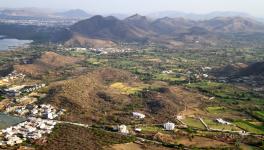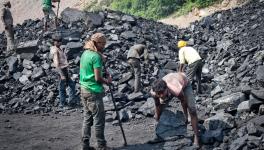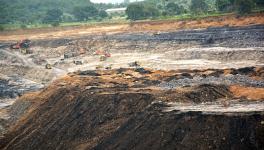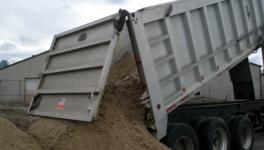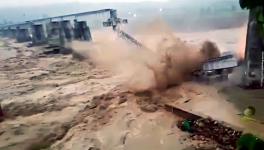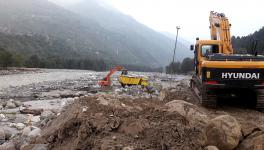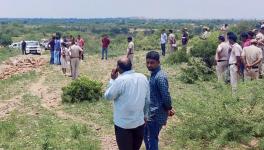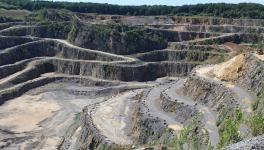South Africa: 78 Miners Found Dehydrated to Death in Police Action
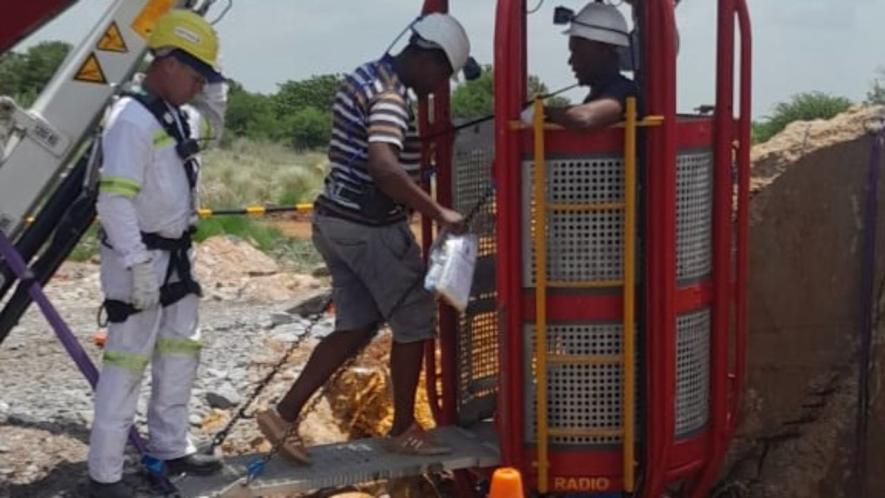
Rescue operation underway in Shaft 11. (Photo: GIWUSA)
The bodies of 78 artisanal miners, starved and dehydrated by the South African Police which had trapped them underground since last August in a crackdown on illegal mining, were retrieved from the Buffelsfontein gold mine’s Shaft 11 last week.
Dozens more bodies and body parts allegedly remain in the Shaft 10 of this abandoned mine in the town of Stilfontein, 150 km southwest of Johannesburg. Without retrieving the dead bodies or searching for survivors in this shaft, the police have announced the end of the rescue operation, which they had prevented for months until a court ordered it on January 10.
Beginning on January 13, the rescue operation was concluded on January 16, hauling out 246 emaciated survivors from Shaft 11. Even as they struggled to walk, with little muscle left on their bony frames, most of them were arrested by the police for illegal mining.
“There has been an explosion of unlicensed, artisanal mining in recent years,” explained Mametlwe Sebei, president of the General Industries Workers Union of South Africa (GIWUSA), to Peoples Dispatch. With the deepening of neoliberal de-industrialization, companies have abandoned an estimated 6,000 mines over the last two decades, without properly sealing the entrances.
Left in the lurch, large sections of the mining community, unable to find other jobs amid the worsening unemployment crisis, have been eking out a living from these abandoned mines. Descending on ropes without adequate safety gear into the dark bowels of some of the deepest mines in the world, they dig for leftover deposits of gold.
The government estimates that it loses a billion dollars annually due to this illicit mining. In the absence of government oversight, crime syndicates have capitalized on this underground economy.
To address this problem, “we have to develop a regulatory regime that allows licensing of artisanal miners and provides them with proper equipment to ensure they work safely, efficiently and productively,” maintains Sebei.
“According to the government over 2,000 of these abandoned mines still have substantial deposits of minerals. If capitalized, it can become a source of employment for hundreds of thousands of miners and unemployed people across the country,” he added. Instead, the government has criminalized the artisanal miners, who are among the poorest of the poor working class — mostly migrants from neighboring countries.
Crackdown on the mine in Buffelsfontein
A nation-wide crackdown on such miners was launched in December 2023 under the name Operation Vala Umgodi (Plug the Hole). In August, the police came for the miners in Buffelsfontein, abandoned by a mining company in 2014. Chasing away the workers on the surface who were operating the pulley to lower down food, water and the miners themselves into shaft 11, the police removed the ropes, trapping the miners 2 km underground with no supplies.
“There are makeshift shops underground, where miners can buy food and water for gold,” Sebei said. But without fresh supplies from the surface, underground stocks quickly ran out. It was November by the time the first tranche of food and water was permitted by the police after protests by the community, said Sebei, who was involved in the months-long legal battle to secure their rescue.
“But they dismantled the pulley again.” Even after a court order in December instructing the police to permit community members to supply the miners underground, “police repeatedly interfered with the pulley system and blocked the supplies,” he added.
“They were demanding that the miners should come out and surrender. But there is no lift, no staircase, there was no way the miners could come out of Shaft 11” without the pulley and ropes, he explained.
Severed body parts in Shaft 10
Desperate, many of the stranded miners made a treacherous journey to Shaft 10 which has a pole they were hoping to climb back up. Crawling for 3 to 4 days in narrow, dark, flooded tunnels, often “with no sense of direction when their lights ran out of battery”, the miners who had not perished enroute reached Shaft 10, Sebei said.
“Climbing from its bottom to the surface took another three days on average,” he added. Weakened by hunger and dehydration, many of them, unable to continue holding on to the handlebars of the pole, fell back to the bottom of the 2.5 km-deep shaft. The impact of their falling bodies against the handlebars they had already climbed below “cut them to pieces”.
Those who successfully endured this climb were arrested. Since November, over 1,500 miners had surfaced before the rescue commenced on January 15, according to the police. They had either managed to climb out of Shaft 10 or journeyed on to shafts of neighboring mines, Sebei said.
The police used the first few miners they arrested “in dubious press conferences to claim that they have options to take other exits, but choose to remain underground” to evade arrest.
“But when I spoke to those miners, they refuted everything they told the media. They had been pressured by the police. They told me all the miners were desperate to come back up. That was evident because every time we sent a rope down with supplies, a miner came back up with it. Not once did the rope come back up empty. Every time the police disrupted the pulley, miners died underground,” he told Peoples Dispatch. But too weak to crawl to other shafts, many stayed behind, dying a slow death from starvation and dehydration while awaiting rescue.
“We are going to smoke them out”
“We are not sending help to criminals. We are going to smoke them out,” cabinet minister Khumbudzo Ntshavheni said in November. Instead of dismantling the pulley, if the police had offered to lift the miners out of Shaft 11 after cutting off supplies, everyone could have been arrested without loss of lives or incurring the expenditure for the rescue operation, Sebei argued. But insisting that the miners had other exits they could take, the police blocked supplies and stalled rescue for months.
Finally, on January 10, in a case brought by Zinzi Tom for the rescue of her 26-year-old brother Ayanda, the Pretoria High Court ordered a rescue operation. A crane was brought in to lower down a cage into Shaft 11. But the state refused to provide search-and-rescue professionals to go underground. The company it had hired for the rescue operation threatened to leave unless two people from the local mining community volunteered, Sebei said.
The deathly stench
In an act of repentance for his past, 36-year-old Mzwandile Mkwayi, who was released from prison in 2021 after serving a seven-year term for robbery, volunteered for the mission, along with Mandla Charles. Pooling in money, community members organized rituals and ceremonies to protect the duo from evil spirits, before they were lowered in the cage into the deathly stench at the bottom of Shaft 11 where dozens of the bodies were decomposing. After hauling 78 dead bodies and helping up another 246 survivors, they were welcomed by their community as heroes.
But their heroism has left them scarred. Mkwayi is unable to eat the meat. Survivors had reportedly told him that apart from cockroaches, many of them had sustained by consuming human flesh of their fellow dead miners.
Rescue volunteers intimidated
Mkwayi has not been provided with counseling. Instead, the police arrested him after he spoke to the media, claiming that he had missed community service, in violation of his parole terms, said Sebei. After 48 hours in jail, he was released with a prohibition against speaking to the media. “This is a clear attempt to intimidate and silence him, preventing him from revealing the testimony of atrocities at Shaft 10,” GIWUSA said in a statement.
“Mkwayi is one of the only two witnesses to the scene of more extremely horrific and massive deaths at Shaft 10,” GIWUSA said. Severed limbs and other body parts of the miners, who fell to their deaths midway through their climb, still hang from the handlebars of this pole their bodies crashed against during the fall, added Sebei. Headless torsos lie in the bottom of Shaft 10, “which the police insisted was a viable exit.”
The other volunteer, Charles, has not been unreachable over the phone after the first few interviews he gave to the press. Having argued in court that the Shaft 10, which is scattered with body parts, was a viable exit for the miners, the police want to suppress the truth about the “horrors of Shaft 10”, Sebei maintains.
Plumes of smoke rising from the area after an explosion heard by the local residents prompted rumors that the police had bombed this shaft in an attempt to destroy evidence amid calls for an inquiry. While refuting this claim, the police are not allowing anyone at the site to verify, said Sebei.
Several miners, including Ayanda Tom, whose sister Zinzi brought the case in which the court ordered the rescue, remain missing. “The survivors last saw him two weeks ago,” Sebei said. Convinced that no rescue was arriving after months at the bottom of Shaft 11, he set off crawling in search of alternative exits.
“We believe” that many miners including Ayanda “have been in Shaft 10, possibly dead, injured or too weak to get to Shaft 11 to be rescued,” GIWUSA said in its statement.
Demanding a professional rescue team be sent down this shaft with sniffer dogs to retrieve the dead bodies and search for any survivors, it added: “We cannot accept a situation where hundreds of community members know all the names… of miners who went down into the shaft and who were not rescued, and now they are just expected to accept that those miners are trapped down there forever. If they are alive, they will die gruesome deaths and if they are dead, their bodies will never be found.”
Lives of survivors in danger
Lives of the survivors who were rescued also hang in the balance. They are in danger of life-threatening malnutrition, typhus and heavy metal toxicity which “may cause multiple organ damage”, warned Healthcare Workers 4 Palestine – South Africa (HCW4P-SA).
“Due to a combination of factors such as immune-compromise due to malnutrition and prolonged time in damp, enclosed spaces, the risk of contracting TB is high and poses a significant health risk if left undiagnosed. Without proper screening and treatment, there is also a significant risk of spread” of the disease.
Pointing out that the preliminary assessment by on-site paramedics is not adequate to screen for these risks, HCW4P-SA has called for “urgent in-hospital assessment”. However, the police have hospitalized only 32 of the 246 survivors to hospital as of Tuesday, January 21, holding the rest in custody.
“All the miners currently hospitalized and some at the detention facility are exhibiting refeeding syndrome, a potentially lethal condition that occurs when malnourished individuals suddenly consume food or fluids, leading to severe electrolyte imbalances. These imbalances then trigger heart and kidney failure, and eventual demise, if not properly managed in a hospital setting,” the Mining Affected Communities United in Action (MACUA) said in a statement on January 20.
Doctors treating the hospitalized miners, shackled to their beds despite being barely able to walk, have “informed us that they have never seen this kind of starvation before… They have advised that it would be difficult to assess the health of those” held in police custody “without performing tests on them” in a hospital, the statement added.
With legal representation from Lawyers for Human Rights, MACUA has raised concerns with the attorneys of the state and the Health Minister, that “without an individual and comprehensive medical assessment of each detainee rescued from shaft 11, including laboratory analyses and radiological imaging, there is an imminent risk of severe health consequences, and even possible death.”
Get the latest reports & analysis with people's perspective on Protests, movements & deep analytical videos, discussions of the current affairs in your Telegram app. Subscribe to NewsClick's Telegram channel & get Real-Time updates on stories, as they get published on our website.









